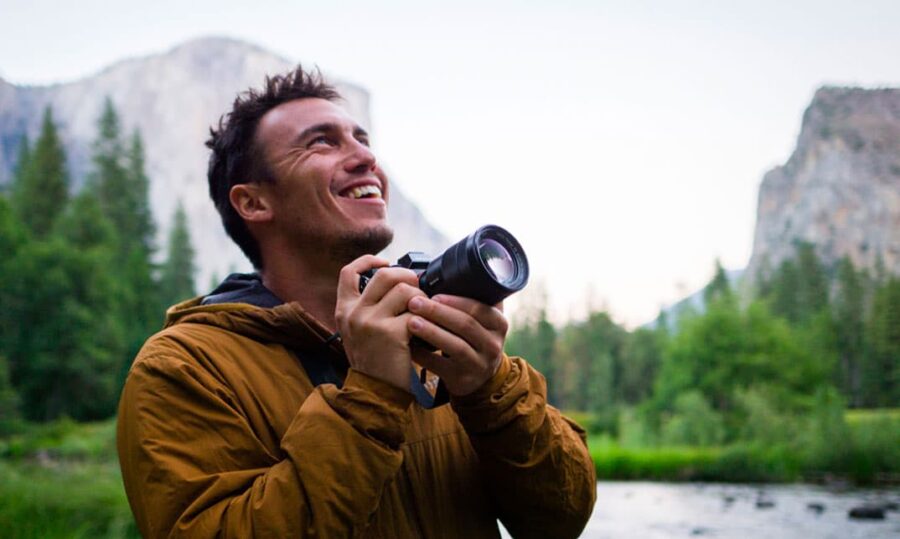The human connection to the natural world often appears fragmented by urban realities and the fleeting nature of digital screens. Chris Burkard has established himself as a central figure in contemporary photography, his name inextricably linked with the aesthetic of untamed wilderness and humanity’s profound interaction with it. From a self-taught surf photographer, Chris Burkard has evolved into a globally celebrated artist, filmmaker, and dedicated environmentalist. His works, frequently created in the most remote and inhospitable regions of the Earth, transcend the boundaries of traditional landscape photography, becoming profound narratives about human identity in the face of monumental nature.
Chris Burkard’s oeuvre is more than mere depiction; it is a powerful return to the primal fascination with adventure and reverence for nature. He acts not only as a chronicler of breathtaking landscapes but also as a catalyst for a cultural awareness that conveys the urgency of environmental protection through the lens of beauty. His creation is an eloquent plea for the transformation of our perception and actions, an invitation not just to observe the wilderness, but to grasp its essence and protect it.
Context and Artistic Signature: From Wave to Wilderness
Chris Burkard’s artistic journey began on California’s Central Coast, where, raised near the ocean and engaged in water sports like bodyboarding and surfing, he discovered photography as a form of expression. As an autodidact, he acquired his skills through intensive “trial and error” and continuously developed them through self-study. This early practice of being “in-the-moment,” immersing himself in the scene to capture friends surfing and the movement of water, profoundly shaped his approach, allowing him an intimate connection to the medium, which he found essential, unlike the more detached role of a mere “spectator” in painting.
Chris Burkard’s visual language is characterized by a unique blend of energy and tranquility, often accentuated by untamed, powerful landscapes. He masters the art of subtly integrating the human element into the vastness of nature to create scale and an emotional connection for the viewer. His intuitive handling of light – be it the play of backlighting, the dramatic shadows in cold, harsh environments, or the capture of the Milky Way – lends his works an unmistakable depth and authenticity. He strives to depict places as realistically as possible, with minimal editing, to present the scene as it appeared to the natural eye. This approach aligns with his conviction that true beauty lies in detail and raw reality, not in over-staging.
The evolution in Chris Burkard’s work reveals a conscious artistic transformation of his perspective. He began as a surf photographer, documenting the action of his friends and the waves, a very subjective and action-oriented viewpoint. However, he found this orientation limiting and recognized the need to expand his expressive range. His later work, particularly in the inhospitable, cold regions, shifts the focus from pure surf action to the monumental expanse of the landscape and the subtle, often effort-filled, human interaction with it. This shift from surface to depth, from pure action to contemplation, is an artistic credo in Chris Burkard’s work. His ability to view the same scene from different angles – from macro shots of tiny waves to aerial views of entire landscapes – is not just a technical skill, but an an expression of his philosophical stance that true art lies in the multifaceted nature of perception.
Chris Burkard’s autodidactic nature is not merely a biographical detail but a central aspect of his artistic authenticity. He emphasizes that personal work ethic and determination can often lead further than an academic degree. Without the constraints of formal education, he developed an unadulterated, intuitive approach to photography. This allowed him to cultivate an instantly recognizable style shaped not by academic conventions, but by personal experience and passion. This approach reinforces the credibility of his philosophy of “not overthinking” and “minimal editing”, as it results from a direct, non-academic engagement with the medium and nature.
The Philosophy of Suffering: Transformation and the Quest for Authenticity
A central, often discussed element in Chris Burkard’s work is the so-called “art of suffering” or “privileged suffering”. He deliberately seeks out extreme, inhospitable environments – icy oceans, remote mountains, harsh winter landscapes – to photograph there. This suffering, however, is not an end in itself, but a conscious act of exposing oneself to discomfort to expand the boundaries of one’s own creativity and human experience. It is a catalyst for deeper experiences and the creation of more meaningful images.
For Chris Burkard, the projects for which one “suffers” are the truly good ones. The physical and mental exertion required to photograph at minus 20 degrees in Iceland or bikeraft through impassable terrain leads to a more intense connection with the moment and the subject. He emphasizes that the camera was once a “filter” for him, helping him process a complicated world. But consciously putting the camera down to process these experiences without the pressure of photographing feels healing to him and allows for a deeper engagement. This reflection underscores a personal transformation that goes beyond mere image production.
The concept of “privileged suffering” is more than just a description of his working method for Chris Burkard; it is a conscious artistic strategy for achieving authenticity and immersion. He chooses these harsh conditions himself; no one forces him. He states that when he creates artworks, stories, or narratives, he wants to feel present in that moment, and that this is often what suffering brings about. In a world where images are often easily accessible and manipulated, Chris Burkard creates inherent credibility by enduring hardships. “Suffering” is the price for deeper immersion in the subject, allowing him to create images that are not only visually stunning but also emotionally resonant. It is a form of “performance art” where the process of creation is inextricably linked to the final product, conveying a tangible authenticity to the viewer. This stands in contrast to the often-criticized superficiality of digital photography.
The artist’s transformation through the experience of suffering is another essential aspect. Chris Burkard reflects that he sometimes has to put his camera down to process experiences and heal. He describes how he “trembles” after trips where he has seen things many people will never experience. Suffering is thus not only a means to an end for the image but a transformative process for Chris Burkard himself. The extreme conditions and isolation in the wilderness force him into deep self-reflection and growth that goes beyond purely photographic skill. These personal experiences flow into his storytelling and lend his works an additional layer of depth and humanity. It becomes clear that his art is shaped not only by nature but also by his own identity and transformation through these encounters.
Chris Burkard’s motivation has changed throughout his career. Initially, it was about “collecting stamps in his passport”, but he quickly realized he wanted to bring back something meaningful – stories from places that have no voice of their own. Storytelling is now at the core of his work, whether through photography, film, books, or personal appearances. This development shows a maturation from superficial documentation to profound narrative, intended to inspire and provoke thought in the viewer.
Iceland as an Icon: Cultural Significance and Ecological Commitment
Iceland is far more than just a travel destination for Chris Burkard; it is a recurring muse, a laboratory for his artistic development, and a focal point of his ecological commitment. He has visited the island over 40 times and has built a deep, personal connection to its unique natural beauty and its people. His first trips there were dedicated to finding waves, but the relationship with the island evolved into diverse projects, including his poignant book At Glacier’s End, which documents Iceland’s dwindling glaciers.
Chris Burkard deliberately uses his photography as a powerful tool for environmental protection. He believes that anyone who shares something meaningful and worthy of protection is an environmentalist, giving a voice to the voiceless. His work in Iceland is a prime example of the transformative power of his images in environmental protection: when the Icelandic government wanted to use his photographs to highlight the threat to river systems, Chris Burkard actively engaged. This led to an invitation to speak at an environmental conference, and his efforts significantly contributed to the vote for the creation of a new national park – an immense success for environmental protection.
The aestheticization of threat is a profound aspect of Chris Burkard’s work that serves as a catalyst for action. He photographs the breathtaking beauty of Iceland, but he does so with the knowledge of the threats these places face. He states it succinctly: “If I’m photographing something I love and fear losing most, I’m doing my job”. His images of melting glaciers are direct, visual testimony to climate change. Chris Burkard transforms landscape photography from a mere celebration of beauty into an urgent visual warning. His images are not just documentation, but aesthetic appeals that highlight the vulnerability of nature. By portraying the beauty of threatened places so vividly, he creates an emotional connection with the viewer that goes beyond mere facts and motivates action. This is a subtle yet powerful form of political art that elevates the discourse on environmental protection to a deeper, more personal level.
Chris Burkard sees his camera as a powerful tool for positive change. His strategy is not to lecture people, but to inspire them through the beauty and rawness of nature to go out and experience these places themselves. He is convinced that only personal experience can evoke lasting appreciation and the desire for protection. This commitment extends beyond his professional work; he lives a sustainable lifestyle and collaborates with numerous environmental organizations, underscoring his authenticity as an advocate.
Chris Burkard acts as a cultural translator, bridging the gap between often inaccessible wilderness and urban society. He sees it as part of his mission to “bring photos from deep in the wilderness back to civilization and show his followers what the outdoors is really like”. He wants to inspire people to “get off their couch and go explore something new”. His photographs are not just representations, but invitations to immersion and empathy. He creates a visual language that allows the urban viewer to experience the essence of the wilderness and develop a responsibility for its preservation, without having to endure the extreme conditions themselves. This expands the cultural significance of his work far beyond the art world into the realm of environmental education and activism.
Reception and Discourse: Influence on Contemporary Photography
Chris Burkard has established himself as one of the most successful and renowned adventure and travel photographers in the world. His works are commissioned by Fortune 500 clients such as Apple, Toyota, and Patagonia and appear in prestigious publications like The New Yorker and National Geographic Adventure. With millions of social media followers, he is referred to as a “Top Travel Influencer”, which gives him immense reach for his messages.
Chris Burkard’s style has significantly shaped the aesthetic of outdoor photography. He combines the dynamism of surf and action sports with the vastness and sublimity of the landscape. His emphasis on natural light, minimal editing, and the integration of the human element for perspective has created a recognizable style that is instantly identified by editors and the public. He advises aspiring photographers to develop a recognizable style and to focus on the emotion in the image, not just the action or logos.
The question of whether photography can exist as a “true” art form alongside painting and sculpture is an ongoing discourse in the art world. Critics argue that photography lacks the “depth and substance” inherent in painting. Chris Burkard’s work, characterized by authenticity, emotional depth, and a clear intention – the preservation of wilderness – contributes significantly to the legitimation of photography as an independent and powerful art form. His refusal to over-edit or create unrealistic images is a statement against superficiality and for the integrity of the medium. He sees his work as storytelling that goes beyond mere image production and aims to change lives.
Chris Burkard navigates a complex, often contradictory landscape of contemporary visual culture, revealing a paradoxical relationship between influencer status and artistic integrity. He is a “Top Travel Influencer” with millions of followers and works with Fortune 500 clients. At the same time, he emphasizes that social media can create “unrealistic expectations”, and he focuses on “minimal editing” to maintain authenticity. He is described as a “humble badass”. Chris Burkard uses the mass reach of digital platforms and commercial partnerships to spread his message without sacrificing his artistic principles of authenticity and respect for nature. This represents an important contribution to the discourse on how artists in the digital age can achieve relevance and impact without falling into the trap of pure commercialization or superficial “content creation.” His career is an example of how to master the balancing act between global reach and profound artistic vision.
Beyond pure aesthetics, Chris Burkard’s work makes a crucial contribution to cultural memory and the transformation of the human relationship with nature. He is motivated to “tell stories that inspire humans to reconsider their relationship with nature and promote the preservation of wild places everywhere”. He photographs places that may “not exist for much longer”. His book At Glacier’s End documents Iceland’s dwindling glaciers. His photographs serve as a visual archive of threatened landscapes and document the effects of climate change. They are not only artworks but also historical testimonies and urgent admonitions. This fosters a transformation in the viewer’s consciousness, from passive appreciation to active responsibility for the preservation of these places. His art thus becomes a medium for the collective search for identity in the face of a changing world.
Chris Burkard is far more than a photographer; he is a visual philosopher whose lens captures the raw beauty of the world while simultaneously revealing its fragility. His “privileged suffering” in the most remote corners of the Earth is not only the source of breathtaking images but a profound act of self-discovery and a tribute to the transformative power of nature. Through his art, which ranges from the Californian wave to the icy expanses of Iceland, Chris Burkard has redefined landscape photography, elevating it to a powerful tool for environmental protection. He reminds us that the wilderness is not just a place we visit, but an integral part of our collective memory and our future. His legacy lies not only in the millions of images he has created but in the way he inspires us to reconsider our own relationship with nature and actively participate in its preservation. In a world increasingly characterized by alienation, Chris Burkard’s work offers an insightful and resonant invitation to reconnect – a transformation that can begin in each of us, if only we dare to gaze into the unknown.









